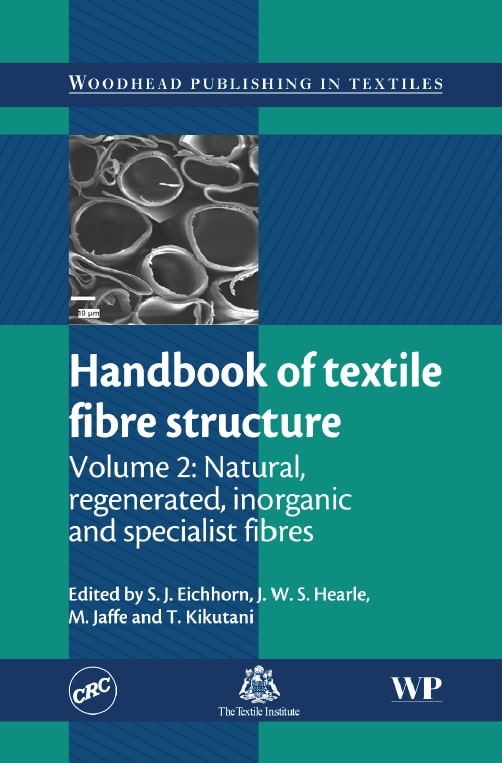
Contents
Contributor contact details xi
Part I Natural fibres
1 An introduction to cellulosic fibres 3
D Ciechańska, E. Wesołowska and D Wawro, Institute of Biopolymers and Chemical Fibres, Poland
1.1 Introduction 3
1.2 Organic and inorganic cellulose solvents 13
1.3 Chemical, physical and biochemical modification of cellulose structure 19
1.4 Overview of technologies for spinning cellulosic fibres 25
1.5 Cellulose-based composite fibres 36
1.6 Prospectives – nanocellulosic fibres 46
1.7 References 51
2 The structure of cotton and other plant fibres 62
M P Ansell, University of Bath, UK and L Y Mwaikambo, University of Dar es Salaam, Tanzania
2.1 Introduction 62
2.2 Categorization of plant fibres 63
2.3 Composition and structure of plant fibres 63
2.4 Structure of seed fibres: cotton, kapok and akund 77
2.5 Structure of bast fibre bundles: jute, kenaf, hemp and flax 81
2.6 Structure of leaf fibres: sisal and banana 84
2.7 Structure of fruit fibres: coir and oil palm empty fruit bunch 87
2.8 Conclusions 89
2.9 References and further reading 90
3 An introduction to protein fibres 95
J W S Hearle, University of Manchester, UK
3.1 Introduction 95
3.2 Protein structures 96
3.3 The diversity of protein fibres 99
3.4 Conclusion 105
3.5 References 106
4 The structure and properties of wool and hair fibres 108 F-J Wortmann, University of Manchester, UK
4.1 Introduction 108
4.2 Keratin fibres 109
4.3 Chemical composition 111
4.4 Fibre formation 115
4.5 Morphology 117
4.6 Molecular structures 121
4.7 Mechanical properties and models 125
4.8 Thermal transitions 128
4.9 Conclusions 138
4.10 Sources of further information and advice 138
4.11 References 139
5 The structure of silk 146
F Vollrath, D Porter and C Dicko, University of Oxford, UK
5.1 Introduction 146
5.2 Silk mechanics 147
5.3 Silk composition 152
5.4 Fine structure and morphology 154
5.5 Spider silk: lessons from nature 164
5.6 Silk fibre and its models 175
5.7 Influence of structure on properties 179
5.8 Artificial silks 184
5.9 Conclusions 188
5.10 Acknowledgements 189
5.11 Sources of further information 189
5.12 References 189
Part II Regenerated natural
6 The structure of man-made cellulosic fibres 201 J Ganster and H-P Fink, Fraunhofer-Institute for Applied Polymer Research, Germany
6.1 Introduction and spinning methods 201
6.2 Structural levels and general models 204
6.3 Rayon (viscose)-type fibres 209
6.4 Lyocell-type fibres 218
6.5 Cellulose acetate-based fibres 222
6.6 Future trends 228
6.7 References 229
7 Regenerated protein fibres: a preliminary review 234
M M Brooks, University of Southampton, UK
7.1 Introduction 234
7.2 First and second generation regenerated protein fibres 235
7.3 Third generation regenerated protein fibres 256
7.4 Summary 261
7.5 Notes 261
7.6 Acknowledgements 262
7.7 References 262
8 The structure of alginate, chitin and chitosan fibres 266
B Niekraszewicz, Technical University of Lodz, Poland and A Niekraszewicz, Institute of Biopolymers and Chemical Fibres, Poland
8.1 Introduction 266
8.2 Alginate fibres 266
8.3 Chitin and chitosan fibres 281
8.4 Conclusions 298
8.5 Sources of further information and advice 298
8.6 Acknowledgements 299
8.7 References 299
Part III Manufactured non-polymer fibres
9 The structure and properties of glass fibres 307
F R Jones, University of Sheffield, UK and N T Huff,
Owens Coming Inc., USA
9.1 Introduction 307
9.2 The nature of glass 310
9.3 Fibre manufacture 322
9.4 Strength of glass fibres 326
9.5 Protection of fibres for strength retention 340
9.6 Summary 349
9.7 References 349
10 The structure of carbon fibres 353
O Paris, University of Leoben, Austria and Max Planck Institute of Colloids and Interfaces, Germany and H Peterlik, University ofVienna, Austria
10.1 Introduction 353
10.2 Short historical overview 354
10.3 Types and production of carbon fibres 355
10.4 Fibre structure 357
10.5 Mechanical properties of carbon fibres and their structural origin 368
10.6 Open questions and future directions 372
10.7 Sources of further information and advice 372
10.8 Acknowledgements 373
10.9 References 373
11 Processing, structure and properties of ceramic fibers 378
G Motz, University of Bayreuth, Germany and R K Bordia, University of Washington, USA
11.1 Introduction 378
11.2 Processing, structure and properties of non-oxide fibers 379
11.3 Processing, structure and properties of oxide fibers 398
11.4 Comparison of ceramic fibers 404
11.5 Examples of current and anticipated applications 408
11.6 Research and development priorities 409
11.7 Summary and conclusions 410
11.8 Sources of further information and advice 411
11.9 Acknowledgements 414
11.10 References 414
12 Structure and properties of asbestos 425E J W Whittalar, formerly of Ferodo Ltd, UK
12.1 Introduction 425
12.2 Classification, occurrence and physical properties of asbestos 426
12.3 Amphibole asbestos 428
12.4 Chrysotile 435
12.5 Synthetic asbestos 448
12.6 References 449
13 Thermally and chemically resistant fibres: structure and properties 450 J W S Hearle, University of Manchester, UK
13.1 Introduction 450
13.2 Thermally resistant fibres 451
13.3 Chemically resistant fibres 454
13.4 Conclusion 456
13.5 References 457
14 Structure, properties and characteristics of optical fibres 458
A Argyros, The University of Sydney, Australia
14.1 Introduction 458
14.2 Waveguide concepts 459
14.3 Fibre structure and optical properties 462
14.4 Types of optical fibres, materials and applications 467
14.5 New materials and material combinations in optical fibres 479
14.6 Conclusions 480
14.7 Sources of further information and advice 481
14.8 References 482
15 Production and applications of hollow fibers 485
M T DeMeuse, Celgard, LLC, USA
15.1 Introduction 485
15.2 Background 486
15.3 Types of fibers and general features 489
15.4 Polymers used 492
15.5 Structure–property relationships 495
15.6 Conclusions and recommendations 496
15.7 Sources of further information and advice 497
15.8 References 498
Index 500
